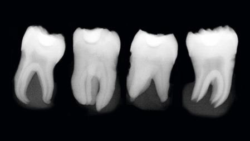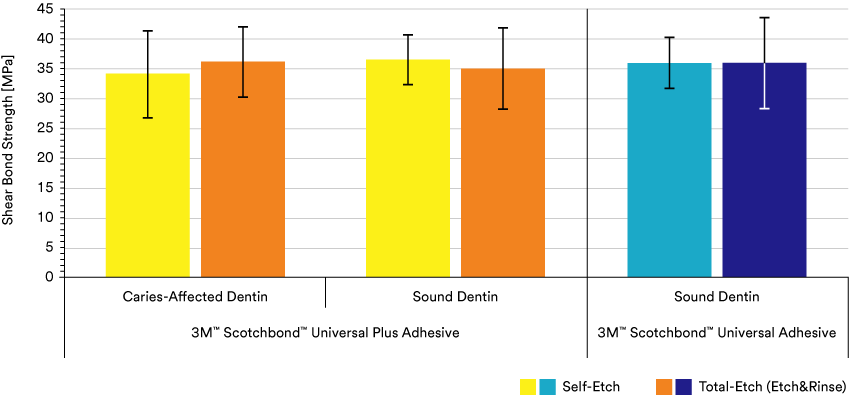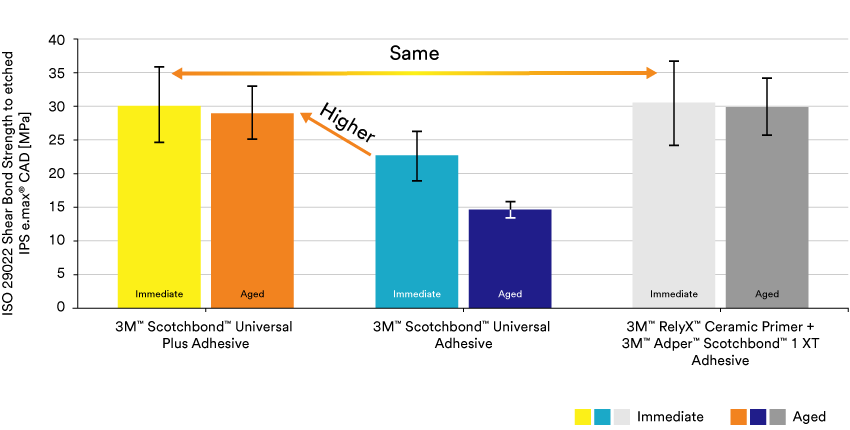Tuesday 29th July 2025
Manufacturers continue to make improvements to dental adhesives to meet clinicians’ modern needs. Universal adhesives in particular offer important advantages in performance and ease of use. A good universal adhesive should include the following characteristics:
Universal adhesives are compelling for these reasons alone, but there are actually five more performance benefits you may not have considered:
1. Radiopacity: Distinguish adhesive layers from
gaps, voids and caries
Most
universal adhesives are radiolucent. On an x-ray, it can be difficult to
differentiate between adhesive pooling, secondary caries, marginal gaps, and
voids beneath the restoration, particularly in hard-to-inspect areas.
Radiolucency under an existing restoration can lead to misdiagnosis – and
potentially invasive overtreatment. To remedy this issue, some manufacturers
add inorganic radiopaque fillers to increase the adhesive’s radiopacity.
However, inorganic fillers can increase the viscosity and affect the
material’s application properties, making handling more challenging. Plus,
fillers tend to settle over time, which can negatively impact the quality of
the product if the bottle is not shaken thoroughly before use.

Intentional adhesive pooling under Class I restorations – X-rays of extracted human molars. The first three molars to the left were treated with different non-radiopaque universal adhesives, while the rightmost molar was treated with 3M™ Scotchbond™ Universal Plus Adhesive.
To avoid potential problems, look for a universal adhesive formulated to achieve dentin-like radiopacity without the addition of radiopaque fillers. 3M™ Scotchbond™ Universal Plus Adhesive, for example, uses a newly developed radiopaque monomer that remains homogeneously distributed in the adhesive and ensures low viscosity.
2. Adhesion to caries-affected dentin: Support minimally invasive procedures
More and more dentists are utilizing minimally invasive approaches and are looking for ways to preserve as much natural tooth structure as possible when removing caries. In most cases, this means leaving caries-affected, but firm, dentin in place on the cavity floor. And in deep cavities, even the soft dentin close to the pulp can be left near the pulp. However, to make this approach successful, there needs to be a tight seal around the carious tissue. The seal cuts off the remaining bacteria from their nutrient supply and stops tooth decay from progressing.
Thankfully, you can
maintain your commitment to minimally invasive restorations and still use a universal adhesive. 3M™ Scotchbond™ Universal Plus Adhesive, for example, has been
formulated for a strong bond to both sound and caries-affected dentin, as
well as seal caries-affected dentin by forming a clearly defined continuous
hybrid layer. This means clinicians can take advantage of the universal
adhesive’s physical properties and workflow benefits while preventing
secondary decay.

Shear bond strength of 3M™ Scotchbond™ Universal Plus Adhesive to caries affected dentin compared to sound dentin.
3. BPA derivative-free formulation: Alleviate patient concerns
Spurred by the increasing discussion around
Bisphenol A in various media, patients and dentists are looking for treatment
options that do not involve formulations based on BPA derivatives, like
BisGMA. To give your patients maximum confidence in the materials you use,
seek out universal adhesives with a BPA derivative-free formulation such as Scotchbond
Universal Plus Adhesive.
4. Function as a primer for indirect
restorations: Improve durability, streamline procedure and reduce inventory
Most dental professionals are used to
applying a primer (e.g., a silane) when bonding to indirect restoration
materials. However, this step can actually be eliminated while improving bond
strength – with the right adhesive.
Usually, dental primers contain a coupling
agent like silane, diluted with solvent. Silanes contain reactive groups that
help promote a bond between organic and inorganic materials, i.e., the tooth
structure and the restoration material. Silanes can be further enhanced by
being paired with a variety of functional groups that improve compatibility
with different polymers.
For example, Scotchbond Universal Plus
Adhesive contains an optimized
mixture of silanes that enable it to function as both a primer and adhesive.
In addition to the methacrylate-functional silanes present in its
predecessor, 3M™ Scotchbond™ Universal Adhesive, the new formulation also
contains amino functional silane. This combination provides gold standard
bond strength to etched glass ceramic.
In fact, several in-vitro studies showed that
the bond strength of Scotchbond Universal Plus Adhesive to etched glass ceramic is
comparable to that of adhesives with a separate silane.

Shear bond strength of 3M™
Scotchbond™ Universal Plus Adhesive to lithium disilicate.2
5. Self-cure and dual-cure: Streamline
procedure, reduce inventory and improve confidence
Acidic adhesive formulations like modern
universal adhesives are often incompatible with the peroxide/amine initiators
used in self-cure and dual-cure products such as resin cements or core
build-up materials, because the acidity can inhibit the cure at the interface
to the adhesive. To overcome this incompatibility, typically a so-called
self-cure activator or dual-cure activator needs to be mixed with the
adhesive as an extra step before application. Scotchbond Universal Plus
Adhesive contains a small
amount of transition metal salt which provides peroxide/amine initiator
compatibility and eliminates the need for a separate activator. However, the
adhesive still needs to be polymerized with a curing light, in order to
ensure maximum performance.
Scotchbond Universal Plus Adhesive has
an additional benefit when used in combination with 3M™ RelyX™ Universal
Resin Cement: the adhesive doesn’t need to be light cured because
the self-curing mechanism of the resin cement also cures the adhesive layer.
This means the adhesive can be optimally distributed by the pressure of
restorative material placement – thereby avoiding any potential fit issues
caused by pooled adhesive cured before placement of the restoration.
Universal adhesives offer many advantages and some materials have
evolved well beyond a strong bond. These next-generation materials are
formulated to address specific dentist needs, such as radiolucency or support
for minimally invasive dentistry. For these reasons, it’s worth taking a
fresh look at universal adhesives – and how the latest advancements could
help you achieve your goals.
References:
1. 3M internal data:
Interaction of an experimental universal adhesive with caries-affected
dentin, C. Thalacker, H. Loll, B. Anich, K. Dede, J. Madden, A.S. Abuelyaman,
B. Craig, J Dent Res 99 (Spec Iss A): No. 191, 2020
2. Optimizing glass-ceramic
bonding incorporating new silane technology in an experimental universal
adhesive formulation, C. Yao, M.H. Ahmed, L. De Grave, K. Yoshihara, B.
Mercelis, Y. Okazaki, K.L. Van Landuyt, C. Huang, B. Van Meerbeek, Dent.
Mater. 2021, 37, 894-90


 EUR (€)
EUR (€)


